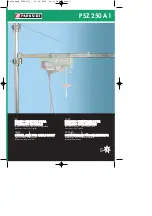
Page 4
SECTION I - INTRODUCTION
Do not change connections in the hoist or the pushbutton
assembly.
CAUTION
2-4. Vent Plug
This hoist has an oil-bath transmission. For shipping purposes,
a non-vented fill plug (39. Figure 8-4) was installed at the
factory. A vented plug is located in an envelope tied to one of
the hoist end covers and must be installed in place of the non
vented shipping plug before operating the hoist.
2-5. Wire Rope Lubrication
It is important that the wire rope is lubricated before the hoist
is put into service. Wire rope lubricant is packed with each
hoist. For lubrication instructions, see paragraph 5-5a. Additional
lubricant is available from your Yale distributor. Specify Part
No. 14J49.
2-6. Testing
a. Before placing the hoist into operation, check for proper
limit switch operation. Push the "UP" button and verify that
the hook block stops at least 2 inches from the bottom of
the hoist. Run the hoist down to its lower limit. At least 2
wraps of wire rope should remain on the drum. If either
switch is not correct, adjust according to the procedure
outlined in paragraph 5-2.
Note
The upper and lower limit switches are factory set to
provide the maximum allowable hook travel. This travel
adjustment should not be increased. However, the
switches may be adjusted to stop the hook sooner at
either end of its travel.
b. Wire rope life can be extended by a short breaking-in
period before the hoist is put into service. During this
breaking-in period, a small amount of twist may show up in
the rope. This twist should he removed as described below.
This break-in can be done at the time of hoist testing:
1. Attach alight load to the hook and run the hoist through
its full lift stroke fora few lifting and lowering cycles. Check
for hook drift. The hook should not drift more than one
inch.
2. If brake operation is normal with a light load, repeat the
above procedure with approximately one-half rated load,
again running the hoist through its full lilt stroke for a few
cycles. Check again for hook drift.
3. If brake operation is normal with one-half rated load,
attach rated load to the hook and continue the break-in
procedure. The hoist shall operate smoothly and the
brake should prevent hook drift in excess of one inch as
rated load. See Paragraph 5-3 if motor brake adjustment
is required.
4. Set the load on the floor. Disconnect the dead end of
the wire rope as described in paragraph 5-4.a.8. Allow
the dead end to rotate, in order to remove all twist from
the rope. Reconnect the dead end and be sure to replace
and tighten the anchor screws.
c. National Electrical Code (ANSI Cl) and local electrical codes
should be consulted and proper disconnects, branch circuit
protectors, and wiring provided.
d. Power cables furnished with the hoist have a green colored
ground wire which must be securely connected to the
electrical system ground.
e. When installing a three-phase hoist, make only temporary
connections at the power line. Push the "UP" button and
observe the direction of the hook. If it raises, the phasing is
correct and permanent connections may be made at the
power line. If the load block lowers when the "UP" button is
pushed, release the button immediately since the limit
switches will not operate to protect the hoist from overtravel.
Reverse the red and black wires at the power line connection
to correct the hook direction.
For more information contact: Sievert Crane and Hoist, (708) 771-1600, [email protected], www.sievertcrane.com





















